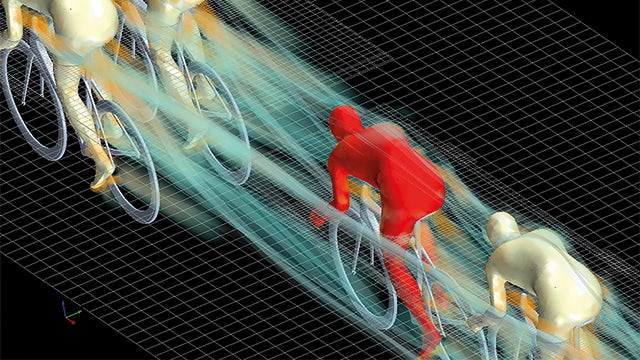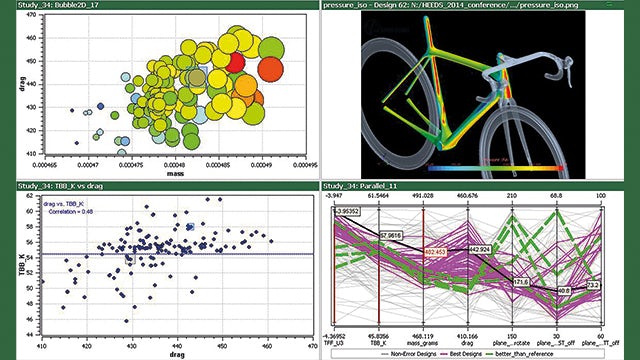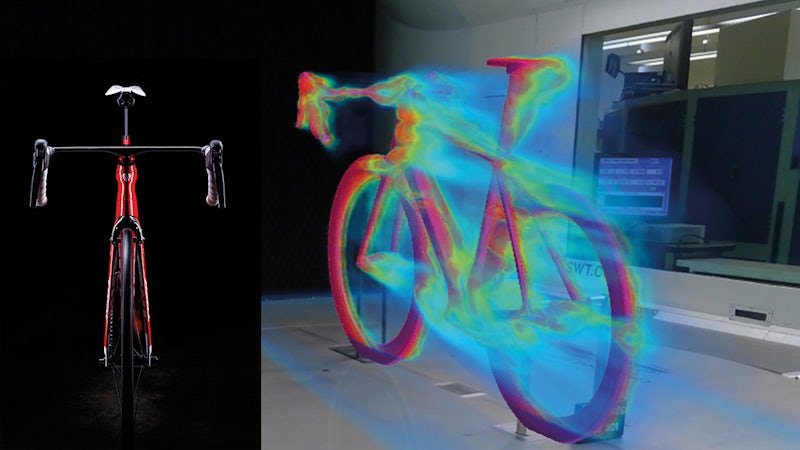Design space exploration enables optimization of bicycle aerodynamics and ride quality
HEEDS and Simcenter STAR-CCM+ help Trek discover better design solutions faster
Trek Bicycle
Trek began in 1976, when two determined guys set out to make the best bicycles the world had ever seen. Their vision was grounded in unswerving principles: the product would be of the highest quality craftsmanship and it would bring the joy of cycling to a broader audience. The company is driven by adventure, guided by its history, inspired by community, enchanted by the freedom of the open road and committed, always, to creating the world’s greatest bicycles.
http://www.trekbikes.com- Headquarters:
- Waterloo, Wisconsin, United States
- Products:
- Heeds, Simcenter Products, Simcenter STAR-CCM+
- Industry Sector:
- Consumer products & retail
Designing second-to-none bicycles
Trek Bicycle Corporation is an American manufacturer of bicycles, cycling components, accessories and apparel whose founders set out in 1976 to make “the best bicycles the world had ever seen.” The company’s vision was grounded on two principles: the product would be of the highest-quality craftsmanship, and it would bring the joy of cycling to a broader audience. Propelled by this vision, Trek is now one of the largest bicycle manufacturers in the world, employing almost 2,000 people and producing about 1.5 million road, mountain and city bikes each year.
While not everyone may think of bicycles as high-tech products, bike design involves complex physics and frequently unknown interactions among multiple physical phenomena. A key challenge is the tradeoff between aerodynamic efficiency optimization and comfort and ride quality. Aerodynamic bikes are traditionally known for their harsh rides and poor handling, Trek notes.
Attacking this challenge in developing its Madone road bike, Trek applied computational fluid dynamics (CFD) together with finite element analysis (FEA) to set a new benchmark for aerodynamics in a bicycle that’s also comfortable to ride and handles smoothly. Aerodynamic performance is most influenced by the geometry of a bicycle’s tubular frame. Aerodynamic tube shapes typically have high aspect ratios, where the depth of the tube is two to three times greater than the width. This provides for a very aerodynamic profile, but the large section properties resist bending, like an I-beam, creating a harsh and unforgiving ride. To overcome this conflict, Trek engineers hit on the solution of separating the aerodynamics from the comfort with a tube-in-tube construction. This new way of designing a frame allowed them to design an outer tube structure optimized for aerodynamics with Kammtail Virtual Foil (KVF) tube shapes – an aerodynamic airfoil design that originated in the auto racing world. Meanwhile, an inner tube structure was optimized for ride comfort by FEA-based tuning of deflection and vertical compliance. These are the properties by which the frame cushions the rider from vibration and road surface irregularities.

Simcenter STAR-CCM+ volume rendering of drafting results.
Automating workflows for bicycle design
A few years ago, Trek engineers began seeking a tool to automate their search for optimized frame designs. They needed a solution that would be compatible with their existing computer-aided engineering (CAE) software – Simcenter TM STAR-CCM+™ for CFD and Abaqus for FEA, as well as their computer-aided design (CAD) system, SolidWorks. They also wanted a tool that did not require a lot of time to set up a problem, processed a fast analysis, and provided the ability to visualize study results and graphically explore the design space. Lastly, because their CFD simulations tend to have long run times, they wanted a software that was cloud HPC (high-performance computing) ready.
The solution that best met their needs was HEEDS™ software, the design space exploration solution from Siemens Digital Industries Software. HEEDS works by capturing and automating an engineer’s current design workflow, based on design and analysis tools of the user’s choice. The user defines design parameters and multidisciplinary design goals, then HEEDS automatically explores the design space to quickly identify feasible solutions that meet all the specified goals.
A proof-of-concept project proved the ability of HEEDS to handle multiple design objectives for bicycle frame optimization. The aim of this study was to minimize aerodynamic drag at the same time as frame mass, while satisfying constraints on both stiffness and baseline mass. Parameters were set to drive the cross-section sketch in a CAD model. Simcenter STAR-CCM+ was used to compute the frame drag, and FEA soft - ware was coupled to the process to calculate mass and stiffness of the frame. HEEDS generated multiple design iterations, numerically and graphically characterizing the key performance attributes of each iteration, and showing how each iteration balanced the tradeoffs between mass, structure properties and aerodynamic drag.
Minimizing the aerodynamic impact of water bottles
Analyzing the impact of water bottle placement on aerodynamics was required in order to discover a design that made the Madone the fastest bike under real-world conditions. The addition of down tube and seat tube water bottles impacts drag by creating additional pressure and disrupting airflow on the tube surfaces. To minimize these unfavorable drag impacts, HEEDS was used to explore optimal water bottle locations to minimize overall frame drag.
In the starting CAD model, water bottles were mounted on the down tube and seat tube at arbitrary points on a prototype frame. Each bottle’s original location was marked with respect to the center of the bottom bracket – the component that connects the crankset (chainset) to the bicycle and allows the crankset to rotate freely. HEEDS then iterated over new designs (new bottle positions), progressively adjusting the iteration input values according to the prior drag responses. After 140 iterations, the final result showed a 5.5 percent reduction in overall drag. In this study, the aggregate result showed the preference to place the seat tube bottle as low as possible toward the bottom bracket, while keeping its influence minimal on the down tube. The seat tube is an important area for determining overall bike drag and affects the bike’s yawing ability, so keeping this tube as exposed as possible would minimize the drag penalty.
The most important benefit of HEEDS, Trek’s engineers say, is what they call an ensemble-based analysis, wherein trends for achieving the objective become apparent once sufficient data are produced via design space exploration. This uncovers previously unknown correlations among design variables and performance attributes, as well as deepening engineers’ insight into already known phenomena. Beyond furthering their understanding of the underlying physics of their designs, it also inspires them to look at problems from multiple viewpoints – indeed, the software sometimes discovers solutions that engineers hadn’t thought of, as occurred in the water-bottle placement study. Because automated design space exploration reveals much more information about a design than the limited number of iterations possible with sequential, manually executed analysis runs, Trek engineers say their conclusions tend to be more objective and data-driven than before.
Previously, when carrying out optimization manually – with CFD and FEA but without HEEDS – engineers would typically analyze 30 to 50 different design iterations for a given problem. Now, HEEDS makes it easy and practical to carry out 500 to 1,000 iterations in the same time or even less. This, in turn, created a new challenge: substantially greater demand for computational resources. Trek turned to cloud computing, taking advantage of the availability of HEEDS on ScaleX, the cloud simulation and HPC platform from Rescale.
Trek benchmarked a typical Simcenter STAR-CCM+ case involving a bike in a wind tunnel model with about 12 million cells. Run time on an old, on-premise HPC device with 12 cores was six hours to extract one drag number. On the ScaleX cloud platform using 64 cores, this fell dramatically, to 42 minutes. Using 96 cores, run time was further compressed to 32 minutes. With 128 cores, run time was just 22 minutes. Instead of waiting almost a full workday for an answer, cloud HPC lets analysts extract an answer in close to real time, file the report and proceed to the next step in their project.

By making previously unknown correlations visible, multidisciplinary design optimization furthers understanding of the underlying physics, inspires dissection of problems from multiple angles, and encourages objective, data-driven conclusions and discoveries.
Four-person drafting: identifying optimal rider assembly configuration for a given wind condition
In a project demonstrating the value of cloud HPC, Trek studied a situation in cycling races where riders group closely together in what’s called a pace line, to conserve energy by reducing wind drag. Using Simcenter STAR-CCM+ and HEEDS in a coupled analysis, engineers ran a simulation on ScaleX to study varying bicycle drafting methods. The case modeled four cyclists in the computational domain, each with X-Y and lateral coordinates. The objective was to identify the optimal rider assembly configuration for a given wind condition. To begin, the CFD case was set up in Simcenter STAR-CCM+. Using an optimization workflow predefined in the ScaleX environment, Simcenter STARCCM+ and HEEDS were coupled in one simulation, and the job was set to run on 64 high-performance cores. The simulation used a steady-state Reynolds-averaged Navier-Stokes (RANS) turbulence model to study aerodynamic impact among several riders. As the HEEDS iterations executed, the analyst could watch each cyclist moving around within the specified domain, with HEEDS exploring and making visible the trends and relationships among variables, and showing the drag reduction converging to a given value. In this way, HEEDS allowed Trek to fully explore the experiment to make informed decisions about the best drafting techniques for competitive cycling.
A giant leap forward
Design space exploration and cloud computing are enabling Trek’s R&D processes to take giant leaps forward. What excites the company most is the prospect of its analysts, design engineers and industrial engineers all being able to brainstorm together more effectively and rapidly than ever, thanks to the design insights available within HEEDS and the quick turnaround times of cloud HPC.

Bicycle design involves conflicting physics and unknown relationships among design variables: structurally optimized shape versus aerodynamically optimized shape; frame geometry, tube shape selection, composite construction; rider configurations and body position.
